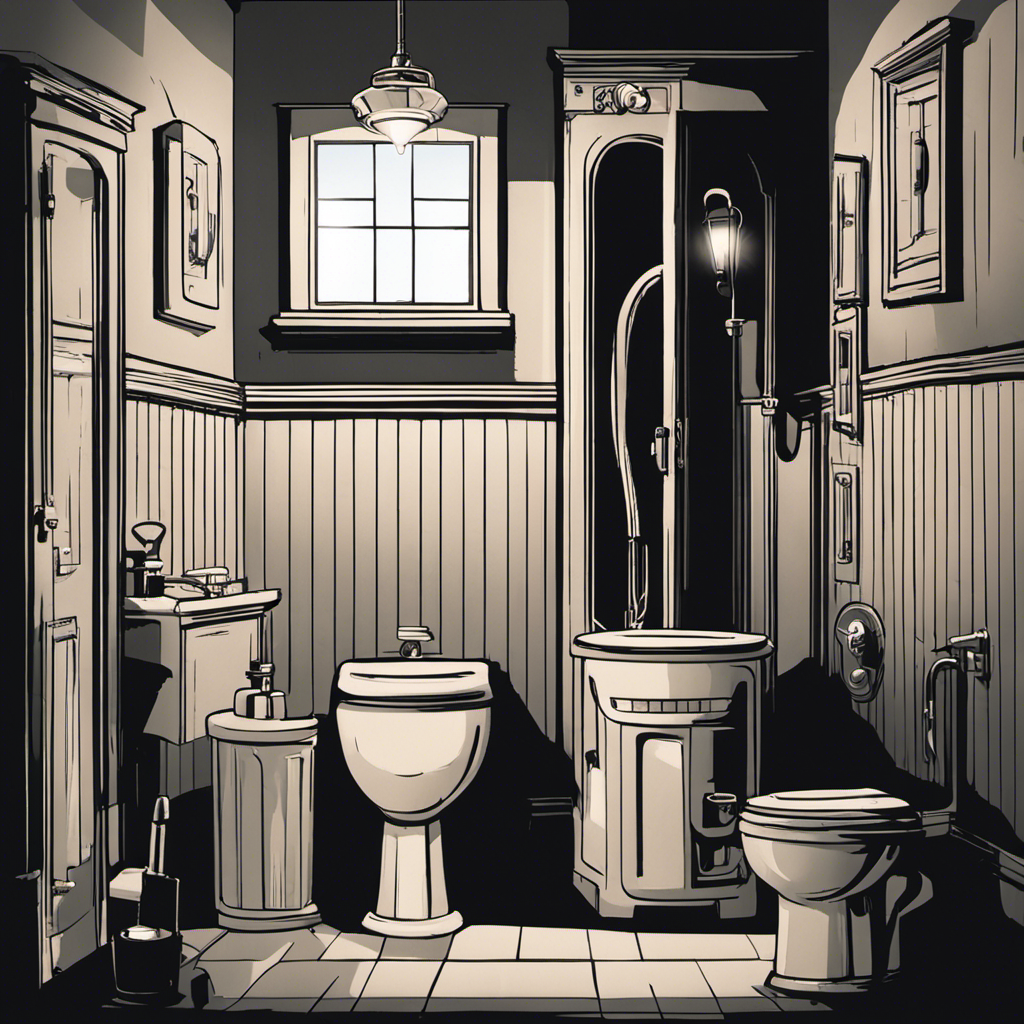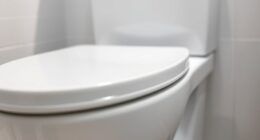As an avid environmentalist, I’ve always been intrigued by innovative ways to conserve water. That’s why I’m excited to share with you today a revolutionary technique: flushing a toilet without water.
In this informative article, we’ll explore the waterless toilet concept and provide you with essential supplies and a step-by-step guide to create your own DIY solution.
We’ll also delve into alternative flush methods, offer tips for odor control, and discuss maintenance and troubleshooting.
Get ready to revolutionize your bathroom routine and make a positive impact on the planet!
Key Takeaways
- Waterless toilets, such as composting toilets and chemical toilets, are effective in conserving water and reducing strain on sewage systems.
- DIY waterless toilet solutions can be easily created using a bucket with a tight-fitting lid, plastic bag, and absorbent material.
- Composting toilets offer a sustainable and chemical-free waste disposal option, transforming waste into compost and eliminating the need for flushing.
- Odor control in waterless toilets can be achieved through the use of odor-reducing additives, natural methods like essential oils or baking soda, regular maintenance, and proper ventilation.
Understanding the Waterless Toilet Concept
Understanding the waterless toilet concept is essential for conserving water. Composting toilets, also known as waterless toilets, are innovative systems that offer a sustainable and eco-friendly solution for waste management. These toilets operate by using natural processes to break down human waste into compost.
The benefits of waterless toilets are numerous and significant. Firstly, they help to conserve water, as they do not require any water for flushing. This is particularly important in areas facing water scarcity or where water conservation is a priority.
Secondly, the compost produced by these toilets can be used as a valuable fertilizer for gardens and agricultural purposes.
Lastly, waterless toilets reduce the strain on sewage systems and eliminate the need for costly infrastructure development.
Overall, understanding the waterless toilet concept is crucial for promoting water conservation and sustainable waste management practices.
Essential Supplies for Flushing Without Water
To properly flush the toilet when there is no water available, you’ll need a few essential supplies.
Portable options and eco-friendly alternatives are available for those looking to conserve water or in situations where water is scarce. One such option is a composting toilet, which uses organic materials to break down waste and does not require water for flushing.
Another option is a chemical toilet, which uses chemicals to break down waste and neutralize odors. These toilets are designed to be portable and can be used in camping or RV situations.
Additionally, there are waterless urinals available that use a special sealant to trap odors and prevent the need for flushing.
Step-by-Step Guide to DIY Waterless Toilet Solution
Using common household items, you can easily create a DIY solution for a waterless toilet. This eco-friendly toilet alternative is a great way to conserve water and reduce your environmental impact.
To create your DIY waterless toilet solution, you will need a bucket with a tight-fitting lid, a plastic bag, and some absorbent material such as sawdust or peat moss.
Start by lining the bucket with the plastic bag, making sure it covers the entire interior. Next, sprinkle a layer of absorbent material at the bottom of the bag. After each use, simply add a layer of absorbent material to cover the waste.
When the bag is full, tie it securely and dispose of it in accordance with local regulations.
Exploring alternative flush methods can provide you with additional eco-friendly options for waste disposal.
Exploring Alternative Flush Methods
When looking for environmentally friendly options, it’s worth exploring alternative methods for waste disposal. Composting toilets are an excellent choice as they provide a chemical-free solution that promotes sustainability.
Here are five key features of composting toilets:
-
Odor control: Composting toilets use natural processes to break down waste, preventing foul odors.
-
Nutrient-rich compost: The waste is transformed into nutrient-rich compost, which can be safely used in gardens and landscaping.
-
Water conservation: Composting toilets eliminate the need for water, reducing water consumption and preserving this precious resource.
-
Easy maintenance: These toilets require minimal maintenance, with regular checks and periodic emptying of the composting chamber.
-
Versatility: Composting toilets can be installed in various locations, including remote areas or homes without access to a sewage system.
Tips and Tricks for Odor Control in Waterless Toilets
When it comes to odor control in waterless toilets, there are several key points to consider.
Firstly, the effectiveness of odor-reducing additives is crucial in maintaining a fresh and odor-free environment.
Secondly, natural odor control methods can also be employed, such as using essential oils or baking soda, which can help neutralize unpleasant smells.
Lastly, regular maintenance is essential for freshness. This includes emptying the waste container, cleaning the toilet bowl, and ensuring proper ventilation to prevent odor buildup.
Odor-Reducing Additives Effectiveness
To effectively reduce odor, you’ll want to consider the effectiveness of odor-reducing additives. These products are designed to neutralize and eliminate unpleasant odors in waterless toilets. Here are some key factors to consider when evaluating the effectiveness of odor-reducing additives:
-
Formulation: Look for additives that contain active ingredients specifically targeted at breaking down and neutralizing odor-causing compounds.
-
Duration: Find additives that provide long-lasting odor control, ensuring a fresh-smelling environment for extended periods.
-
Compatibility: Ensure that the additive is compatible with the materials used in your waterless toilet system.
-
Ease of use: Opt for additives that are easy to apply and integrate into your waterless toilet maintenance routine.
-
Safety: Choose odor-reducing additives that are environmentally friendly and safe for use around humans and pets.
Considering the effectiveness of odor-reducing additives is an important step in DIY odor control for waterless toilets. However, there are also natural odor control methods that can be used in conjunction with these products to further enhance odor reduction.
Natural Odor Control Methods
Natural odor control methods can be a great complement to odor-reducing additives in waterless toilets. By maintaining a balanced carbon-to-nitrogen ratio, regularly turning the compost, and ensuring adequate airflow, the decomposition process can be optimized, minimizing unpleasant odors. Proper management is key when it comes to composting techniques. Additionally, the use of natural air fresheners can further enhance the overall odor control in waterless toilets. Essential oils, such as lavender or lemon, can be added to the composting chamber to provide a pleasant fragrance. These oils not only mask odors but also possess antimicrobial properties, helping to reduce the growth of odor-causing bacteria. Furthermore, the use of activated charcoal filters can effectively absorb and neutralize odorous gases, ensuring a fresh and odor-free environment.
Maintenance Tips for Freshness
Now that we have covered natural odor control methods, let’s move on to maintenance tips for freshness.
Maintaining a fresh-smelling toilet without water requires regular upkeep and the use of effective odor control techniques. Here are some important tips to ensure your toilet stays fresh:
- Regular cleaning: Clean your toilet bowl and seat regularly with a cleaning solution specifically designed for odor control.
- Vinegar solution: Use a mixture of vinegar and water to wipe down the toilet surfaces to eliminate any lingering odors.
- Baking soda: Sprinkle baking soda in the toilet bowl to absorb odors and keep it smelling fresh.
- Essential oils: Add a few drops of your favorite essential oil to the toilet bowl water for a pleasant fragrance.
- Air fresheners: Use odor-neutralizing air fresheners near the toilet area to maintain a fresh scent.
Maintenance and Cleaning of Waterless Toilet Systems
Regular maintenance and cleaning are essential for keeping waterless toilet systems in good working condition. As someone who has installed and used a waterless toilet system, I can attest to the importance of proper upkeep. Here is a table outlining the key maintenance tasks and their recommended frequency:
| Maintenance Task | Frequency |
|---|---|
| Emptying the compost | Every 6-12 months |
| Cleaning the bowl | Weekly |
| Inspecting the vent | Monthly |
| Checking the seals | Every 6 months |
Troubleshooting Common Issues With Waterless Toilets
When troubleshooting common issues with waterless toilets, it’s important to check the ventilation system first. A properly functioning ventilation system is crucial for preventing odor issues and maintaining a healthy environment.
Here are some key steps to take when troubleshooting waterless toilets:
- Check the ventilation pipe for blockages or obstructions.
- Ensure that the vent cap is securely in place and properly sealed.
- Clean the vent pipe and cap regularly to prevent clogs.
- Inspect the fan or blower for any signs of malfunction.
- Test the airflow by using a smoke pencil or tissue near the vent.
Frequently Asked Questions
Can I Use a Waterless Toilet in My RV or Camper?
Yes, you can use a waterless toilet in your RV or camper. Waterless toilets offer numerous benefits for camping and boating, such as conserving water and minimizing odors. To choose the right one for your RV, consider factors like size, installation requirements, and waste management options.
How Often Do I Need to Empty the Waste From a Waterless Toilet?
Maintaining a waterless toilet is simple and efficient. Emptying the waste depends on usage frequency, but generally, it needs to be done every few weeks. The benefits of using a waterless toilet include water conservation and reduced environmental impact.
Can I Use Regular Toilet Paper With a Waterless Toilet?
Regular toilet paper can be used with waterless toilets, but there are alternative options like biodegradable toilet paper. Waterless toilets offer advantages in remote areas by conserving water and reducing the need for plumbing infrastructure.
Are Waterless Toilets More Environmentally Friendly Than Traditional Flush Toilets?
Waterless toilets are more environmentally friendly than traditional flush toilets. They reduce water consumption, which is a huge pro. However, sanitation in developing countries may be negatively impacted due to lack of adequate water supply for cleaning.
Can I Install a Waterless Toilet in My Home Without Any Plumbing Modifications?
I can install a waterless toilet in my home without any plumbing modifications. Waterless toilets have numerous benefits, and there are different types available, such as composting toilets and incinerating toilets.
Conclusion
In conclusion, embracing the waterless toilet concept has been a game-changer for me. By following the step-by-step guide and utilizing alternative flush methods, I have successfully eliminated the need for water in my flushing routine.
Not only have I contributed to water conservation efforts, but I have also experienced the satisfaction of taking control of my own waste management system. The tips and tricks for odor control, as well as the maintenance and cleaning techniques, have further enhanced the efficiency of my waterless toilet.
Join me in this sustainable journey and make a difference today. Let’s flush away our wasteful habits and embrace a greener future.










